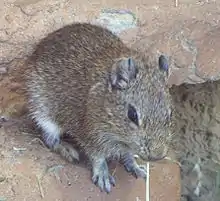Muenster yellow-toothed cavy
The Muenster yellow-toothed cavy (Galea monasteriensis) is a species of rodent in the family Caviidae. It is known only from one location in Valle Hermoso in the Bolivian Andes, at an elevation of 2557 m.[1] Specimens from this location were shipped to Muenster, Germany in 1997 for laboratory research, where the species was recognized and described.[1] Galea monasteriensis was recognized on the basis of morphological, behavioral, and reproductive differences from related species. However, its habits in the wild have not been studied.[1]
| Muenster yellow-toothed cavy | |
|---|---|
 | |
| Scientific classification | |
| Domain: | Eukaryota |
| Kingdom: | Animalia |
| Phylum: | Chordata |
| Class: | Mammalia |
| Order: | Rodentia |
| Family: | Caviidae |
| Genus: | Galea |
| Species: | G. monasteriensis |
| Binomial name | |
| Galea monasteriensis Solmsdorff, Kock, Hohoff & Sachser, 2004 | |
Since 2016, the IUCN has regarded this population as a subspecies of the common yellow-toothed cavy, i.e. as Galea musteloides ssp. monasteriensis.[1]
Unlike the common yellow-toothed cavy and Spix's yellow-toothed cavy, Muenster yellow-toothed cavy males engage in social play with their offspring and groom them rather than being aggressive. When mothers of this species and their pups are put into a strange environment, the presence of the mothers mitigates increases in blood cortisol levels in their pups; however, this is not observed when the pups are moved together with other mothers that are not their own.[2] G. monasteriensis is both sexually and socially monogamous. Both males and females of G. monasteriensis defend their territories and care for their pups.[3]
References
- Dunnum, J.; Vargas, J. (2016). "Galea musteloides ssp. monasteriensis". IUCN Red List of Threatened Species. IUCN. 2016. Retrieved 6 December 2019.
- Adrian, O.; Sachser, N. (2011). "Diversity of social and mating systems in cavies: A review". Journal of Mammalogy. 92: 39–53. doi:10.1644/09-MAMM-S-405.1.
- Hennessy, M. B.; Neisen, G.; Bullinger, K. L.; Kaiser, S.; Sachser, N. (2006). "Social organization predicts nature of infant-adult interactions in two species of wild guinea pigs (Cavia aperea and Galea monasteriensis)". Journal of Comparative Psychology. 120 (1): 12–18. doi:10.1037/0735-7036.120.1.12. PMID 16551160.